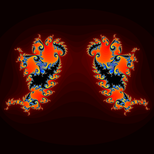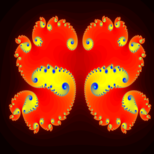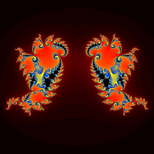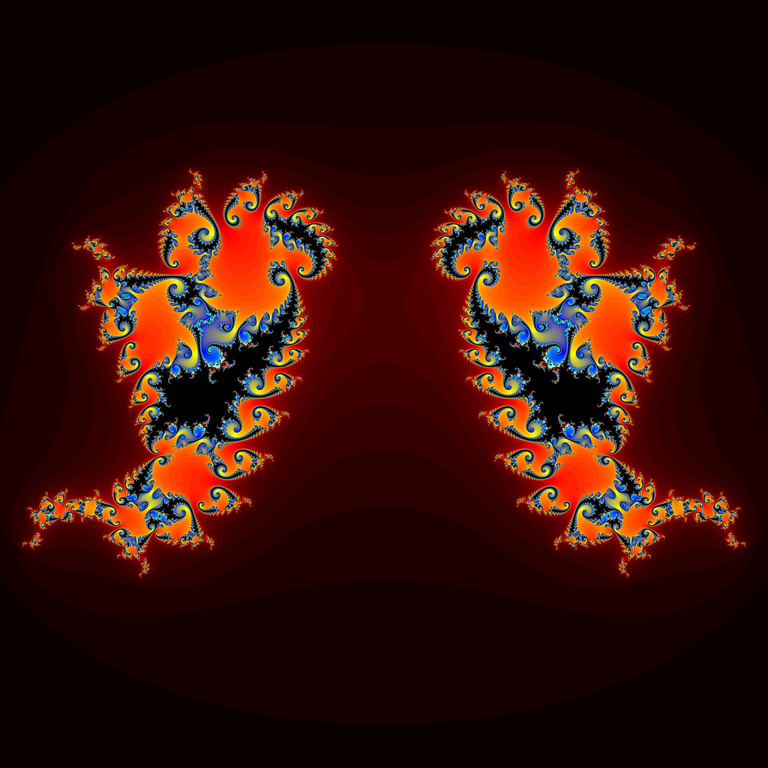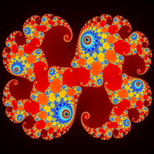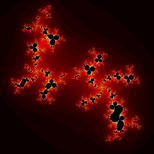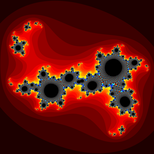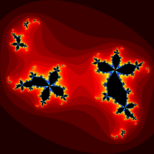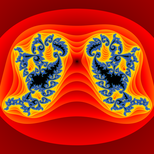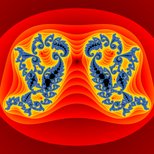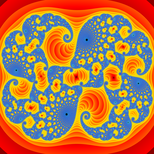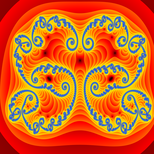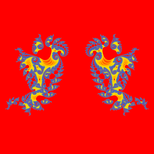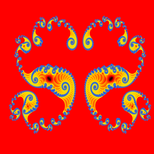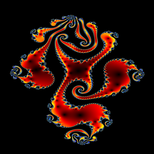Mitch Richling: Phoenix Fractal
| Author: | Mitch Richling |
| Updated: | 2024-10-24 |
Table of Contents
1. Introduction
The Phoenix Fractal is given by the following iteration:
Where
This formula is iterated for each point in the complex plane (z) with the initial conditions:
An exterior distance estimator is given by:
With the initial conditions:
2. Static Image: Escape Time
These fractals are generated in the same manner as Mandelbrot Julia Sets.
2.1. Code
#include "ramCanvas.hpp" typedef mjr::ramCanvas3c8b::colorType ct; std::vector<std::array<double, 9>> params { /* cr, ci, pr, pi, k, x-min, x-max, y-min, y-max */ { 0.566700, 0.00000, -0.50000, 0.00000, 10.0, -1.35, 1.35, -1.35, 1.35}, // 0 { 0.544992, 0.00000, -0.47000, 0.00000, 10.0, -1.35, 1.35, -1.35, 1.35}, // 1 { 0.269000, 0.00000, 0.00000, 0.01000, 5.0, -1.10, 1.10, -1.00, 1.00}, // 2 { -0.400000, 0.10000, 0.29550, 0.00000, 10.0, -1.10, 1.10, -1.50, 1.50}, // 3 { 0.400000, 0.00000, -0.25000, 0.00000, 10.0, -1.30, 1.20, -1.00, 1.00}, // 4 { 0.100000, 0.60000, -0.35000, 0.00000, 10.0, -1.30, 1.30, -1.30, 1.30}, // 5 { 0.400000, 0.40000, 0.20500, 0.00000, 30.0, -1.30, 1.30, -1.30, 1.30}, // 6 { 0.400000, 0.50000, 0.20500, 0.00000, 30.0, -1.30, 1.30, -1.30, 1.30}, // 7 }; int main(void) { std::chrono::time_point<std::chrono::system_clock> startTime = std::chrono::system_clock::now(); const int WIDTH = 1920*4; const int HEIGHT = 1920*4; const int NUMITR = 500; const double MAXZ = 4.0; # pragma omp parallel for schedule(static,1) for(decltype(params.size()) j=0; j<params.size(); ++j) { const std::complex<double> c(params[j][0], params[j][1]); const std::complex<double> p(params[j][2], params[j][3]); mjr::ramCanvas3c8b theRamCanvas(WIDTH, HEIGHT, params[j][5], params[j][6], params[j][7], params[j][8]); for(int y=0;y<theRamCanvas.getNumPixY();y++) { for(int x=0;x<theRamCanvas.getNumPixX();x++) { std::complex<double> z1(theRamCanvas.int2realY(y), theRamCanvas.int2realX(x)); std::complex<double> z2(0.0, 0.0); int count = 0; while((std::norm(z1)<MAXZ) && (count<=NUMITR)) { std::complex<double> z = z1*z1+c+p*z2; z2 = z1; z1 = z; count++; } if(count < NUMITR) theRamCanvas.drawPoint(x, y, ct::csCCfractal0RYBCW::c(static_cast<ct::csIntType>(count*params[j][4]))); } } theRamCanvas.writeTIFFfile("phoenix_" + mjr::math::str::fmt_int(j, 2, '0') + ".tiff"); std::cout << "ITER(" << j << "): " << "DONE" << std::endl; } std::chrono::duration<double> runTime = std::chrono::system_clock::now() - startTime; std::cout << "Total Runtime " << runTime.count() << " sec" << std::endl; }
Source Link: phoenix.cpp
The above program will generate several images includeing this classic:
3. Static Image: Distance Estimator (Outside)
3.1. Code
#include "ramCanvas.hpp" typedef mjr::ramCanvas3c8b::colorType ct; std::vector<std::array<double, 9>> params { /* cr, ci, pr, pi, k, x-min, x-max, y-min, y-max */ { 0.566700, 0.00000, -0.50000, 0.00000, 100.0, -1.35, 1.35, -1.35, 1.35}, // 0 { 0.544992, 0.00000, -0.47000, 0.00000, 100.0, -1.35, 1.35, -1.35, 1.35}, // 1 { 0.269000, 0.00000, 0.00000, 0.01000, 100.0, -1.10, 1.10, -1.00, 1.00}, // 2 { -0.400000, 0.10000, 0.29550, 0.00000, 100.0, -1.10, 1.10, -1.50, 1.50}, // 3 { 0.400000, 0.00000, -0.25000, 0.00000, 100.0, -1.30, 1.20, -1.00, 1.00}, // 4 }; int main(void) { std::chrono::time_point<std::chrono::system_clock> startTime = std::chrono::system_clock::now(); const int WIDTH = 1920*1; const int HEIGHT = 1920*1; const int NUMITR = 500; const double MAXZ = 4.0; # pragma omp parallel for schedule(static,1) for(decltype(params.size()) j=0; j<params.size(); ++j) { const std::complex<double> c(params[j][0], params[j][1]); const std::complex<double> p(params[j][2], params[j][3]); mjr::ramCanvas3c8b theRamCanvas(WIDTH, HEIGHT, params[j][5], params[j][6], params[j][7], params[j][8]); for(int y=0;y<theRamCanvas.getNumPixY();y++) { for(int x=0;x<theRamCanvas.getNumPixX();x++) { std::complex<double> d1(1.0, 0.0); std::complex<double> d2(0.0, 0.0); std::complex<double> z1(theRamCanvas.int2realY(y), theRamCanvas.int2realX(x)); std::complex<double> z2(0.0, 0.0); int count = 0; while((std::norm(z1)<MAXZ) && (count<=NUMITR)) { std::complex<double> z = z1*z1+c+p*z2; std::complex<double> d = 2.0*d1*z1+p*d2; z2 = z1; z1 = z; d2 = d1; d1 = d; count++; } if(count < NUMITR) theRamCanvas.drawPoint(x, y, ct::csCCfractal0RYBCW::c(static_cast<ct::csIntType>(std::log(std::abs(d1)+1)*params[j][4]))); } } theRamCanvas.writeTIFFfile("phoenixD_" + mjr::math::str::fmt_int(j, 2, '0') + ".tiff"); std::cout << "ITER(" << j << "): " << "DONE " << std::endl; } std::chrono::duration<double> runTime = std::chrono::system_clock::now() - startTime; std::cout << "Total Runtime " << runTime.count() << " sec" << std::endl; }
Source Link: phoenixD.cpp
4. Static Image: Distance Estimator (Inside)
4.1. Code
#include "ramCanvas.hpp" typedef mjr::ramCanvas3c8b::colorType ct; std::vector<std::array<double, 9>> params { /* cr, ci, pr, pi, k, x-min, x-max, y-min, y-max */ { 0.566700, 0.00000, -0.50000, 0.00000, 300.0, -1.35, 1.35, -1.35, 1.35}, // 0 { 0.544992, 0.00000, -0.47000, 0.00000, 1000.0, -1.35, 1.35, -1.35, 1.35}, // 1 { -0.400000, 0.10000, 0.29550, 0.00000, 300.0, -1.10, 1.10, -1.50, 1.50}, // 2 }; int main(void) { std::chrono::time_point<std::chrono::system_clock> startTime = std::chrono::system_clock::now(); const int WIDTH = 1920*4*4; const int HEIGHT = 1920*4*4; const int NUMITR = 500; const double MAXZ = 6.0; # pragma omp parallel for schedule(static,1) for(decltype(params.size()) j=0; j<params.size(); ++j) { const std::complex<double> c(params[j][0], params[j][1]); const std::complex<double> p(params[j][2], params[j][3]); mjr::ramCanvas3c8b theRamCanvas(WIDTH, HEIGHT, params[j][5], params[j][6], params[j][7], params[j][8]); for(int y=0;y<theRamCanvas.getNumPixY();y++) { for(int x=0;x<theRamCanvas.getNumPixX();x++) { std::complex<double> d1(1.0, 0.0); std::complex<double> d2(0.0, 0.0); std::complex<double> z1(theRamCanvas.int2realY(y), theRamCanvas.int2realX(x)); std::complex<double> z2(0.0, 0.0); int count = 0; while((std::norm(z1)<MAXZ) && (count<=NUMITR)) { std::complex<double> z = z1*z1+c+p*z2; std::complex<double> d = 2.0*d1*z1+p*d2; z2 = z1; z1 = z; d2 = d1; d1 = d; count++; } if(std::norm(z1)<MAXZ) theRamCanvas.drawPoint(x, y, ct::csCCfractal0RYBCW::c(static_cast<ct::csIntType>(std::log(std::abs(d1)+1)*params[j][4]))); } } theRamCanvas.scaleDownMean(4); theRamCanvas.writeTIFFfile("phoenixI_" + mjr::math::str::fmt_int(j, 2, '0') + ".tiff"); std::cout << "ITER(" << j << "): " << "DONE " << std::endl; } std::chrono::duration<double> runTime = std::chrono::system_clock::now() - startTime; std::cout << "Total Runtime " << runTime.count() << " sec" << std::endl; }
Source Link: phoenixI.cpp
5. Making Movies
Becasue the phoenix has a couple free parameters, we can easily make movies by sweeping these parameters through a sequence of values.
5.1. Sweeping p
The following code will sweep
#include "ramCanvas.hpp" typedef mjr::ramCanvas3c8b::colorType ct; int main(void) { std::chrono::time_point<std::chrono::system_clock> startTime = std::chrono::system_clock::now(); const int WIDTH = 1920/2; const int HEIGHT = 1920/2; const int NUMITR = 500; const double MAXZ = 4.0; const int NUMFRM = 24*2; const double ANGMIN = 0.0; const double ANGMAX = std::numbers::pi*2; const double RADIUS = 0.0001; # pragma omp parallel for schedule(static,1) for(int frame=0; frame<NUMFRM; frame++) { # pragma omp critical std::cout << "Frame: " << frame << std::endl; double angle = frame*(ANGMAX-ANGMIN)/NUMFRM+ANGMIN; const std::complex<double> c(0.566700, 0.00000); const std::complex<double> p(-0.50000+RADIUS*std::cos(angle), 0.00000); mjr::ramCanvas3c8b theRamCanvas(WIDTH, HEIGHT, -0.75, -0.5, 0.13, 0.32); for(int y=0;y<theRamCanvas.getNumPixY();y++) { for(int x=0;x<theRamCanvas.getNumPixX();x++) { std::complex<double> z1(theRamCanvas.int2realY(y), theRamCanvas.int2realX(x)); std::complex<double> z2(0.0, 0.0); int count = 0; while((std::norm(z1)<MAXZ) && (count<=NUMITR)) { std::complex<double> z = z1*z1+c+p*z2; z2 = z1; z1 = z; count++; } if(count < NUMITR) theRamCanvas.drawPoint(x, y, ct::csCCfractal0RYBCW::c(static_cast<ct::csIntType>(count*10))); } } theRamCanvas.writeTIFFfile("phoenixM_" + mjr::math::str::fmt_int(frame, 2, '0') + ".tiff"); # pragma omp critical std::cout << "FRAME(" << frame << "): " << "DONE" << std::endl; } std::chrono::duration<double> runTime = std::chrono::system_clock::now() - startTime; std::cout << "Total Runtime " << runTime.count() << " sec" << std::endl; }
Source Link: phoenixM.cpp
The result is the following movie:
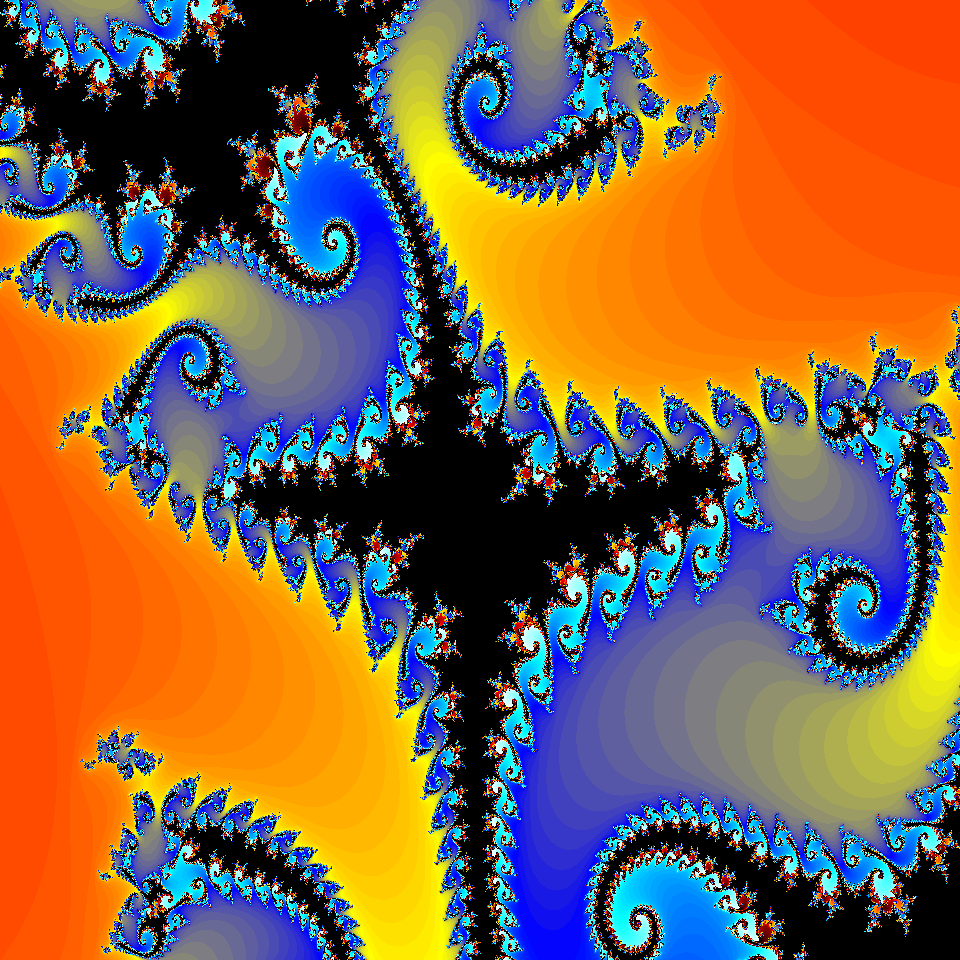
5.2. Sweeping both c & p
The following code will sweep
#include "ramCanvas.hpp" typedef mjr::ramCanvas3c8b::colorType ct; int main(void) { std::chrono::time_point<std::chrono::system_clock> startTime = std::chrono::system_clock::now(); const int WIDTH = 1920/2; const int HEIGHT = 1920/2; const int NUMITR = 40; const double MAXZ = 4.0; const int NUMFRM = 24*2; const double ANGMIN = 0.0; const double ANGMAX = std::numbers::pi*2; const double RADIUS = 0.06; # pragma omp parallel for schedule(static,1) for(int frame=0; frame<NUMFRM; frame++) { # pragma omp critical std::cout << "Frame: " << frame << std::endl; double angle = frame*(ANGMAX-ANGMIN)/NUMFRM+ANGMIN; const std::complex<double> c(-0.400000+RADIUS*std::cos(angle), 0.10000+RADIUS*std::sin(angle)); const std::complex<double> p(0.29550+RADIUS*std::cos(angle), 0.00000+RADIUS*std::sin(angle)); mjr::ramCanvas3c8b theRamCanvas(WIDTH, HEIGHT, -1.10, 1.10, -1.50, 1.50); for(int y=0;y<theRamCanvas.getNumPixY();y++) { for(int x=0;x<theRamCanvas.getNumPixX();x++) { std::complex<double> z1(theRamCanvas.int2realY(y), theRamCanvas.int2realX(x)); std::complex<double> z2(0.0, 0.0); int count = 0; while((std::norm(z1)<MAXZ) && (count<=NUMITR)) { std::complex<double> z = z1*z1+c+p*z2; z2 = z1; z1 = z; count++; } if ((count < NUMITR) && (count > 5)) theRamCanvas.drawPoint(x, y, ct::csCCfractal0RYBCW::c(static_cast<ct::csIntType>(std::log(count)*110))); } } theRamCanvas.writeTIFFfile("phoenixM2_" + mjr::math::str::fmt_int(frame, 2, '0') + ".tiff"); # pragma omp critical std::cout << "FRAME(" << frame << "): " << "DONE" << std::endl; } std::chrono::duration<double> runTime = std::chrono::system_clock::now() - startTime; std::cout << "Total Runtime " << runTime.count() << " sec" << std::endl; }
Source Link: phoenixM.cpp
The result is the following movie:

